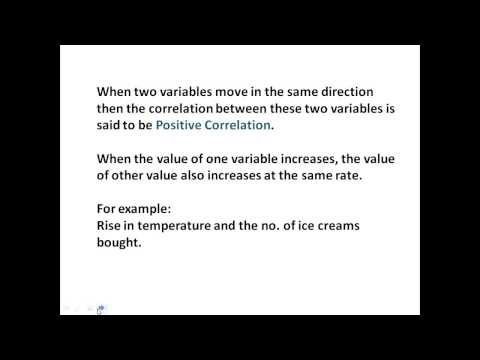Contents:

Self-selection is a term used to describe what happens when survey respondents are allowed to deny participation in a survey. The belief is that respondents who are opposed or who are apathetic about the objectives of the survey refuses to participate, and their removal from the sample bias the results of the survey. Self-selection can also occur since respondents who are either strongly opposed or strongly supportive of a survey’s objectives respond to the survey. Science – Science is the accumulation of knowledge acquired by careful observation, by deduction of the laws which govern changes and conditions, and by testing these deductions by experiment.

- A discrete random variable can take on a distinct value while a continuous random variable is defined for an interval of values.
- A simple table gives the frequency, or the percentage, in each category.
- If there are other categorical variables, their values can be indicated using different plotting symbols or different colours.
- Population – It is the total collection of cases people wish to generalize the results of their study to.
In other words, strata are a variable whose value is a numerical outcome of a random phenomenon is calledly selected such that inter-strata variability is maximized, and intra-strata variability is small. When stratified sampling is performed as desired, estimates of strata statistics are more precise than the same estimates computed on a simple random sample. Smoothing – It is the process of removing fluctuations in an ordered series so that the result is ‘smooth’ in the sense that the first differences are regular and higher order differences are small. Although smoothing can be carried out by free-hand methods, it is normal to make use of moving averages or the fitting of curves by least squares procedures.
Practice Questions on Random Variable
Finally, type I and type II errors refer to specific interpretive errors made when analyzing the results of hypothesis tests. Random variables are needed because probability distributions are insufficient to describe realistic random phenomena. Indeed, in practical problems we often only have realizations of random variables to work with, and rarely have a formula for their probability distribution.

Post hoc test – The post hoc test is used at the second stage of the analysis of variance or multiple analyses of variance if the null hypothesis is rejected. Non-linear relation – A non-linear relation is one where a scatter plot between two variables X1 and X2 does not produce a straight-line trend. In several cases a linear trend can be observed between two variables by transforming the scale of one or both variables. For example, a scatter plot of log and X2 can produce a linear trend.
What Is The Difference Between Variable And Discrete Random Variable?
When these ‘lumpy’ data are smoothed appropriately, the data are thought to better reflect the true process which generated the data. An example is the speed-time trace of a vehicle, where speed is measured in integer kilometres per hour. Accelerations of the vehicle computed from differences in successive speeds are over-estimated because of the lumpy nature of measuring speed. Hence, an appropriate smoothing process on the speed data results in data which more closely resembles the underlying data generating process. Of course, the technical difficulty with smoothing lies in selecting the appropriate smoothing process, since the real data are never typically observed. Prediction interval – A prediction interval is a calculated range of values known to contain some future observation over the average of repeated trials with specific certainty .

Variability or variation or dispersion – The variability in data is the extent to which successive values are different. The quantity of variability in the data, and the different causes of the variability are frequently of importance in their own right. The variability (or ‘noise’) in the data can also obscure the important information (or ‘signal’). Universe – Universe is synonymous with population and is found primarily in older statistical textbooks. Majority of the newer textbooks and statistical literature use population to define the experimental units of primary interest. Test of hypothesis – It is a statistical test of the plausibility of the null hypothesis in a study.
Mean And Variance Of Discrete Random Variable
The Question and https://1investing.in/s have been prepared according to the CA Foundation exam syllabus. Information about Age of a person isa)An attributeb)A discrete variablec)A continuous variabled)A variableCorrect answer is option ‘C’. Find important definitions, questions, meanings, examples, exercises and tests below for Age of a person isa)An attributeb)A discrete variablec)A continuous variabled)A variableCorrect answer is option ‘C’. A discrete random variable X has a countable number of possible values.
Random variables are often used in econometric or regression analysis to determine statistical relationships among one another. The realizations of a random variable, that’s, the outcomes of randomly choosing values in accordance with the variable’s likelihood distribution function, are referred to as random variates. This section covers Discrete Random Variables, likelihood distribution, Cumulative Distribution Function and Probability Density Function. In that instinct a random variable is a few value of the state, which is random as a result of we don’t know the state of the system. Examples of discrete random variables include the values obtained from rolling a die and the grades received on a test out of 100.
The quantities most commonly used to measure the dispersion of the values about their mean are the variance s2and its square root , the standard deviation s. The variance is calculated by determining the mean, subtracting it from each of the sample values , and then averaging the squares of these deviations. The mean and standard deviation of the sample are used as estimates of the corresponding characteristics of the entire group from which the sample was drawn. Theydo not, in general, completely describe the distribution of values within either the sample or the parent group; indeed, different distributions may have the same mean and standard deviation. They do, however, provide a complete description of the normal distribution, in which positive and negative deviations from the mean are equally common, and small deviations are much more common than large ones. For a normally distributed set of values, a graph showing the dependence of the frequency of the deviations upon their magnitudes is a bell-shaped curve.
Deep-Manager: a versatile tool for optimal feature selection in live … – Nature.com
Deep-Manager: a versatile tool for optimal feature selection in live ….
Posted: Fri, 03 Mar 2023 17:49:01 GMT [source]
This process is repeated to create multiple copies of one’s data; then one’s statistical analysis of the data is repeated with each copy of the dataset and the results are combined into one final set of results. Maximum likelihood method – It is a method of parameter estimation in which a parameter is estimated by the value of the parameter which maximizes the likelihood function. In other words, the maximum likelihood estimator is the value of theta which maximizes the probability of the observed sample. The method can also be used for the simultaneous estimation of several parameters, such as regression parameters. Estimates obtained using this method are called maximum likelihood estimates. Hypothesis – A statistical hypothesis is a hypothesis concerning the value of parameters or form of a probability distribution for a designated population or populations.
Random Variable
Partial regression coefficient – It is the coefficient for a predictor in a regression model which contains more than one explanatory variable. It represents the effect of that predictor controlling for all other predictors in the model. Opinion – It is a belief or conviction, based on what seems probable or true but not demonstrable fact. The collective views of a large number of people, especially on some particular topic. Several studies have shown that individuals do not possess the skills to adequately assess risk or estimate probabilities, or predict the natural process of randomness. One-way analysis of variance – It is an extension of the independent group t-test where one has more than two groups.
Assortativity in cognition Scientific Reports – Nature.com
Assortativity in cognition Scientific Reports.
Posted: Tue, 28 Feb 2023 12:41:19 GMT [source]
Wilcoxon sign rank test – it is a non-parametric statistical hypothesis test for the case of two related samples or repeated measurements on a single sample. It can be used as an alternative to the paired student’s t-test when the population cannot be assumed to be normally distributed. Time series – It is a series of measurements of a variable over time, normally at regular intervals. It is a set of ordered observations on a quantitative characteristic of an individual or collective phenomenon taken at different points of time.
If the mean number of arrivals during a 15-minute interval is understood, the Poisson chance mass operate given by equation 7 can be utilized to compute the chance of x arrivals. In this approach, a random perform on is considered a operate of two variables and which is -measurable for each (that’s, for mounted it reduces to a random variable defined on the likelihood house ). A random outcome is just a random result that can be obtained from an action or an experiment. It cannot describe an outcome numerically and hence the option is not the correct answer. For a random variable, the outcome of a random experiment is mapped onto variable, e.g., a number. A Bernoulli random variable is given by \(X\sim Bernoulli\), where p represents the success probability.
The variance becomes more useful in its own right when the contribution of different sources of variation are being assessed. This leads to a presentation called the ‘analysis of variance’, frequently written as ANOVA. Type I error – It is the probability of rejecting a true null hypothesis in a statistical test.
